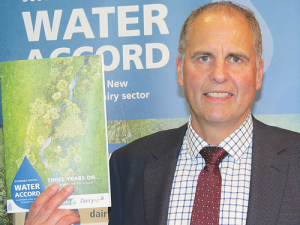The targets in the Sustainable Dairying Water Accord are effectively becoming normal business practice for dairy farmers, says a DairyNZ director, Alister Body.
He made his comments at the release of a three year review of the accord, which covers a range of environmental targets dairy farmers are encouraged to achieve voluntarily. All dairy companies – except Westland which runs its own scheme -- support the targets, as do the regional councils, Federated Farmers and some other agri-related organisations.
Body says the accord was agreed to and signed without a specific end date, but the signatories agreed to the three-year report on what has and has not been achieved.
On the plus side, the report states that 97% of dairy farms have fenced waterways and nearly 100% of farms have bridges or culverts over streams where cows cross. It says dairy companies have assessed all dairy farms for effluent systems and a dairy effluent warrant of fitness scheme is available to farmers. The target of having new dairy farm conversions comply with environmental standards has been achieved on time.
However, a plan to exclude stock from wetlands has not been achieved and the target to have about half of dairy farms put in place a riparian management plan is only half achieved. Also not completed on time is a plan to have nutrient management data collected from all farms.
Overall the report is a mixed bag, but there is commitment from DairyNZ and the other parties to achieve the targets set out in the accord. It is uncertain how this will be achieved.
Body says in the early days some of the targets were seen as a stretch for farmers, but he reckons this has now changed.
“Dairy farmers are expected to do these things on a day to day basis,” he told Rural News. “If you look at the way regional councils and planning procedures are going, the movement is for each farm to have an environmental management plan.
“Those plans are all the things we are talking about such as fencing, bridges and nutrient management; so really we think the future for this accord is going to be quite different.”
Body would prefer to see something more high level and strategic, and not applying only to dairy farmers, but to all farmers. One of the concerns he and others have raised is the need for accurate national data on significant non-compliance by dairy farms. The problem is that regional councils have different systems that make it hard to get fair comparisons.
The report shows that of the major dairy regions, Taranaki has by far the lowest incidence of significant non-compliance – a mere 0.8%. Conversely, Waikato is 10% and Northland 14%. Others such as Bay of Plenty and Canterbury are about 5% and the West Coast just 2.5%.
While these results are likely to draw protest from some quarters, Body says it’s important to get accurate data so the industry knows where it stands. He says the good news is that, in general, farmers are moving towards good management practice and farm environmental plans and farmers will be audited on these.
On the issue of not all waterways being fenced, Body believes this is due to the terrain of some parts of farms and regular flooding.
“In difficult country where streams flood regularly you can’t simply put up a permanent or semi-permanent fence,” he explains. “There are places where Waratahs will get washed away in floods.”



















